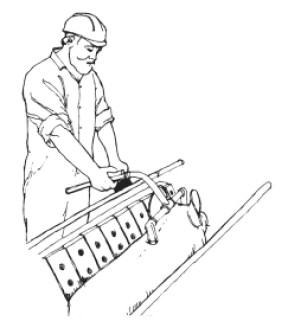 |
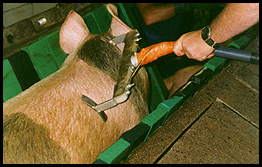 |
(Updated June 2022)
Effective stunning methods are readily available to induce instantaneous insensibility. Good reviews on captive bolt stunning can be found in Leach (1984), Grandin (1994a) and Eikelenboom (1983). Electrical stunning methods used commercially on pigs and sheep are effective and induce instantaneous insensibility. A minimum of 1.25 amps must be passed through a pig's brain to reliably induce insensibility (Hoenderken, 1982). In sheep, 1 amp is required (Gregory and Wotton, 1984).
Unlike pigs and sheep, a single current passed from the neck to the brisket failed to induce epileptiform changes in the electroencephalogram of cattle (Cook et al., 1993). In cattle, a split stun procedure is used. A 1.5 amp current must first be applied to the head before a head-to-body current is applied.(Gregory, 1993; OIE 2009). Reviews by Warrington (1974), Leach (1985),Grandin(1985; 1986; 2010; 2013) and Gregory (1994) provide further information.
To produce instantaneous, painless unconsciousness, sufficient amperage (current) must pass through the animal's brain to induce an epileptic seizure (AVMA, 2013). Insufficient amperage or a current path that fails to go through the brain will be painful for the animal. It will feel a large electric shock or heart attack symptoms, even though it may be paralysed and unable to move. When electric stunning is done correctly, the animal will feel nothing.
The best electric stunners use an amperage-regulated circuit. The desired amperage is set and voltage varies. In the U.S. and other countries, there are older voltage-regulated units being used. In very small U.S. plants, these units are popular because they are much less expensive. With this type of unit, the desired voltage is set and the amperage varies. The question that has been asked is: Are voltage-regulated units humane? The bottom line is: regardless of circuit design, an electric stunner MUST produce an epileptic seizure. I have observed stunners with fake amperage meters, which makes it look like they are using the correct settings. There are also units available that change the frequency of the current to prevent blood splash damage in the meat. Higher frequencies reduce meat damage, but too high a frequency will fail to induce a seizure. 800hz applied across the head is effective, but the period of insensibility will be shorter (Anil and McKinstry, 1992). Frequencies over 800hz are usually not recommended. Since it is impossible for plant personnel to all become electrical engineers, when I audit a plant, I look for clinical signs that the stunner is actually creating an epileptic seizure with a tonic (rigid phase) and clonic (kicking paddling) phase.
When an animal is correctly stunned for 1 to 3 seconds with a reversible head only stun, a clear tonic and clonic phase of the seizure can be observed. If the stunner is held on for 30 seconds, the spine will become depolarized and the seizure will not be observed. This animal will be insensible provided that the stunner was capable of producing a seizure when applied for 1 to 3 seconds. When cardiac arrest stunning is used, the signs of a seizure are difficult to observe. Stopping the heart masks the signs of a seizure (Gilbert and Devine 1991). If a sequential stun is used where the current is applied to the head first and then a second current is applied to the heart, it is easy to determine that the stunner is working by delaying the heart stun for a few seconds to observe the tonic and clonic phase. The animal will remain insensible if the heart stun is applied before the clonic (paddling phase) stops. This will solve humane concerns about conducting this test. Failure to do this test would result in thousands of animals that may not be rendered insensible.
In many larger plants, simultaneous head to body stunning is used, where a current is passed through both the brain and the heart at the same time. Many of these units use proprietary amperage regulated and frequency regulated circuits. In most larger plants, the stunner is applied for 2 to 3 seconds. The short time makes it possible to see signs of a weak tonic and clonic phase. The clinical signs of the seizure are partially attenuated (reduced) by body stun. If I can observe a weak rigid and clonic phase, I know the stunner is working and inducing instantaneous insensibility. The trend in animal welfare is to use animal based outcome measures. The OIE and AMI minimum settings are a minimum baseline. I do not fully trust the meters because I have seen too many fake things and 1.25 amps may be too low for either large pigs or dehydrated animals. Animals that are dehydrated are more difficult to electrically stun. It is also not possible to safely train auditors and inspectors to open up electrical equipment and test it. To insure humane slaughter, looking at a meter is not sufficient to determine if electrical stunning is creating instantaneous insensibility. An inspector or auditor needs to see signs of a seizure. In sheep, EFSA (2015) and Humane Slaughter Association (2013) recommend 1 amp.
There is sometimes a conflict between effective electric stunning and meat damage, such as blood spotting. If meat damage occurs, management may reduce the amperage setting. To provide effective stunning and low levels of meat damage requires attention to details of the procedure. Placement of the stunning wand (tongs) is critical. Regular assessment of current through the brain is essential. The brain MUST be in the current path. Meat damage can be reduced by firm placement of the electrodes and avoiding sliding or intermittent contact.
Solving problems with elecric stunning which may cause poor welfare or meat damage:
 |
 |
There are two types of electric stunning, head only and cardiac arrest stunning, which stops the heart. Most large plants use cardiac arrest head to back or head to side of body stunning. It produces a still carcass that is safer and easier to bleed. Cardiac arrest stunning requires the use of a restraining device to prevent the animal from falling away from the stunning wand before it receives the complete stun. Cardiac arrest stunning kills the animal by electrocution. Head only stunning is reversible. Pigs and sheep which are stunned with a head only stunner must be bled within a maximum interval of 30 seconds to prevent them from regaining consciousness. An interval of 10 to 17 seconds is recommended.
When cardiac arrest stunning is used, one electrode must be placed on either the forehead or in the hollow behind the ears, and the other electrode is placed on either the back or the side of the body. The head electrode should not be allowed to slide back onto the neck. When head only stunning is used, the electrodes may be either placed on the forehead or clamped over around the sides of the head like ear muffs. Pigs should be wetted prior to stunning. The stunning wand must be applied to the animal for two to three seconds to stun properly. Stunners should be equipped with a timer.
(June 2008 Update): Many very small plants have problems with pigs or sheep returning to sensibility after head only stunning. Their hoist is so slow that bleeding within 10 to 15 seconds is difficult. For plants that use a head only stunner that has two prongs, the following procedure can be used. Apply to the head first to induce insensibility and then apply a second time to the side of the animal right behind the front leg (Vogel et al, 2010). This is a simple way to convert ahead only stunner to a cardiac arrest stunner. To reliably prevent return to insensibility, the heart shock must be applied immediately, within 15 seconds after the head stun. If stunning tongs are used, they can be clamped across the animals' body or applied to the chest. THE HEAD STUN MUST BE DONE BEFORE THE STOPPING THE HEART CURRENT. Applying a second current to the chest abolished rhythmic breathing, righting reflex, eye tracking, vocalization (squealing), and natural spontaneous blinking (Vogel et al, 2010). The application of the chest electrode stopped the heart. For plants in the U.S. that use the Best and Donovan electric stunner, wand extensions are available to make the wand fit better on large pigs. A frequency of 50 to 60 cycles (standard house current) is recommended for application to the chest to stop the heart. Practical experience in Europe has shown that a stunner set to 400hz does not work. Unconsciousness can be induced with high frequencies but they will not induce cardiac arrest.
Modern stunning circuits use a constant amperage design. The amperage is set and the voltage varies with pig or sheep resistance. Older style circuits are voltage regulated. These circuits are inferior because they allow large amperage surges which can fracture bones and cause bloodsplash. The distance between the head electrode and the back electrode should not exceed 14 inches. Pig stunners should be equipped with blunt electrodes which do not stick into the animal. The most modern sheep stunners from New Zealand utilize water jets to conduct electricity down through the wool.
Warris et al. (1994) found that pigs were more stressed in abattoirs with single file races compared to plants where pigs were stunned in small groups on the floor. The intensity of squealing was highly correlated with physiological stress measurements and PSE. Electrical stunning of pigs on the floor is most practical for abattoirs that slaughter under 240 pigs per hour. The author has observed that floor stunning often becomes rough and sloppy at higher speeds. In larger plants, a well designed race will produce less stress than a poor one. Weeding et al. (1993) found that both design and staff expertise affected stress levels in pigs. Pigs that jam in the race or are poked with electric prods will have higher lactate and poorer pork quality. The last five minutes before stunning is very critical. Excitement and agitation shortly before slaughter will lower pork quality and raise lactate levels (Edwards et al, 2010ab).
| Pigs move more easily through a ramp where they walk up side by side. The outer sides are solid and the middle partition is "see through" to promote following behaviour. | 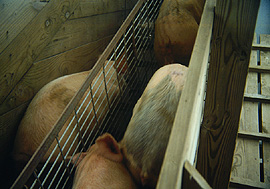 |
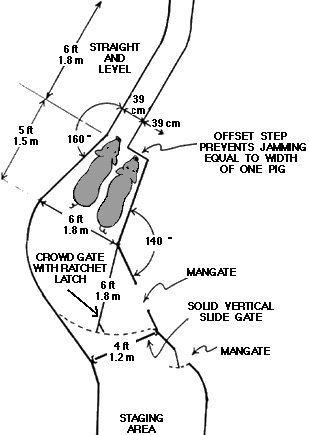 |
On the diagram illustrating a well designed pig race, the double chute is recommended. However, if space restriction is an issue, notice the diagram does promote pigs natural following behavior and prevents jamming with an offset step at the entrance of the chute. With the double chute design, the outer walls are solid, with a "see through" middle partition that further promotes following behaviour. |
| Simple Crowd Pen for Pigs This design has an offset step that helps prevent pigs from jamming at the entrance of the single file race. The step is equal to the width of one pig, approximately 18 inches (45 cm). The pen should work in the position shown on the diagram. Small groups of pigs should be moved. Good handling will require more walking. |
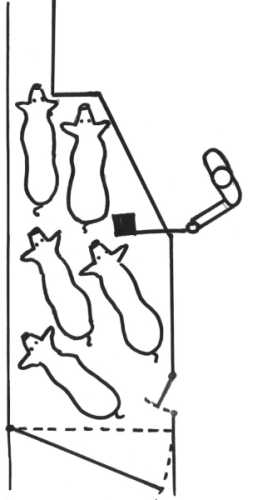 |
Handlers also need to know how to time bringing up bunches of pigs. Pigs will enter the single file race more easily if they can move through the crowd pen without stopping. To accomplish this, the next bunch is not brought in until most of the previous bunch has moved through the single file race. If the crowd pen is filled when the single file race is full, the pigs will be more likely to stop and turn around.
Anil, M.H. and McKinstry, J.L. 1992. The effectiveness of high frequency electrical stunning of pigs. Meat Science. 30:481-491.
(AVMA) American Veterinary Medical Association. 2013. AVMA Guidelines for the euthanasia of animals: 2013 Edition.
Edwards, L.N., et al. 2010. Use of exsanguination blood lactate to assess the quality of pre-slaughter pig handling. Meat Science. 86: 384-390.
Edwards, L.N., et al. 2010. The relationship between exsanguination blood lactate concentration and carcass quality in slaughter pigs. Meat Science. 85: 435-440.
EFSA. 2015. Scientific opinion on the scientific assessment of studies on the electrical parameters of stunning small ruminants (ovine and caprine species). EFSA Journal. DOI: 10.2903/j.efsa.2015.4023.
Grandin, T. 1985/86 (with 1997 updates). Cardiac arrest stunning of livestock and poultry. Advances in Animal Welfare Science, M.W. Fox and L.D. Mickley (Editors), Martinus Nijhoff Publisher
Grandin, T. 2015. Improving animal welfare (2nd Edition): A Practical Approach. CABI Publishing. Wallingford, Oxfordshire, UK.
Grandin, T. 2013. Making slaughterhouses more humane for cattle, pigs, and sheep. Annual Review of Animal Bioscience. 1:491-512.
Grandin, T. and Cockram, M. 2020. The slaughter of farmed animals: Practical ways of enhancing animal welfare. CABI Publishing, Wallingfor, Oxfordshire, United Kingdom.
HSA. 2013. Electrical stunning of redmeat animals. Humane Slaughter Association, UK.
Lambooy, E. 1982. Electrical stunning of sheep. Meat Science. 6:123-135.
Vogel, K.D. et al, 2010. Head only followed by cardiac arrest electrical stunning is an effective alternative to head only electrical stunning in pigs. Meat Science. 89:1412-1418.
 Click here to return to the Homepage for more information on animal behavior, welfare, and care.
Click here to return to the Homepage for more information on animal behavior, welfare, and care.